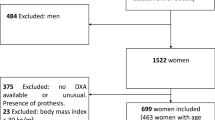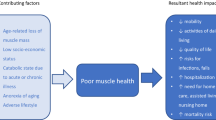Abstract
Background/objectives
To investigate the impact of eliminating fat-free adipose tissue (aFFAT) on the prevalence of low muscle mass in older adults.
Subjects/methods
Three hundred and forty-three (153 men and 190 women) well-functioning Japanese older adults (aged 65–79) had their appendicular lean mass (aLM) and appendicular fat mass (aFM) measured using dual-energy X-ray absorptiometry (DXA). aFFAT was then estimated from DXA-derived aFM (aFM = (FM/0.15)*0.85). Both traditional cutoffs and those corrected for aFFAT were used for diagnosing low muscle mass.
Results
With traditional cutoff values, the prevalence of low muscle mass using the unadjusted aLM index was 20.1%. After adjusting the aLM index for aFFAT, the prevalence increased to 49.0% (p < 0.001). However, when the cutoff values were also adjusted for aFFAT, the prevalence of low muscle mass only increased to 23.0% (p < 0.001). Further, ~5% of the participants (7 men and 8 women) were newly classified as having low muscle mass after correction for aFFAT. However, several women (n = 5) were not classified as having low muscle mass using the corrected cutoff value, although they would have been when using the non-corrected cutoff.
Conclusions
Adjusting for the effect of aFFAT on DXA-derived aLM significantly increases the prevalence of low muscle mass in older adults. For clinical research and practice, the influence of aFFAT on DXA-derived aLM may need to be taken into consideration when diagnosing low muscle mass.
This is a preview of subscription content, access via your institution
Access options
Subscribe to this journal
Receive 12 print issues and online access
$259.00 per year
only $21.58 per issue
Buy this article
- Purchase on Springer Link
- Instant access to full article PDF
Prices may be subject to local taxes which are calculated during checkout

Similar content being viewed by others
References
Shepherd JA, Ng BK, Sommer MJ, Heymsfield SB. Body composition by DXA. Bone. 2017;104:101–5.
Baumgartner RN, Koehler KM, Gallagher D, Romero L, Heymsfield SB, Ross RR, et al. Epidemiology of sarcopenia among the elderly in New Mexico. Am J Epidemiol. 1998;147:755–63.
Cruz-Jentoft AJ, Baeyens JP, Bauer JM, Boirie Y, Cederholm T, Landi F, et al. Sarcopenia: European consensus on definition and diagnosis: report of the european working group on sarcopenia in older people. Age Ageing. 2010;39:412–23.
Chen LK, Liu LK, Woo J, Assantachai P, Auyeung TW, Bahyah KS, et al. Sarcopenia in Asia: consensus report of the asian working group for sarcopenia. J Am Med Dir Assoc. 2014;15:95–101.
Guglielmi G, Ponti F, Agostini M, Amadori M, Battista G, Bazzocchi A. The role of DXA in sarcopenia. Aging Clin Exp Res. 2016;28:1047–60.
Visser M, Fuerst T, Lang T, Salamone L, Harris TB. Validity of fan-beam dual-energy X-ray absorptiometry for measuring fat-free mass and leg muscle mass. J Appl Physiol. 1999;87:1513–20.
Levine JA, Abboud L, Barry M, Reed JE, Sheedy PF, Jensen MD. Measuring leg muscle and fat mass in humans: comparison of CT and dual-energy X-ray absorptiometry. J Appl Physiol. 2000;88:452–6.
Kim J, Wang ZM, Heymsfield SB, Baumgartner RN, Gallagher D. Total-body skeletal muscle mass: estimation by a new dual-energy X-ray absorptiometry method. Am J Clin Nutr. 2002;76:378–83.
Chen Z, Wang ZM, Lohman T, Heymsfield SB, Outwater E, Nicholas JS, et al. Dual-energy X-ray absorptiometry is a valid tool for assessing skeletal muscle mass in older women. J Nutr. 2007;137:2775–80.
Abe T, Patterson KM, Stover CD, Young KC. Influence of adipose tissue mass on DXA-derived lean soft tissue mass in middle-aged and older women. Age (Dordr). 2015;37:9741.
Beaudart C, Rizzoli R, Bruyere O, Reginster JY, Biver E. Sarcopenia: burden and challenges for public health. Arch Public Health. 2014;72:45.
Loenneke JP, Loprinzi PD, Abe T. The prevalence of sarcopenia before and after correction for DXA-derived fat-free adipose tissue. Eur J Clin Nutr. 2016;70:1458–60.
Weir JP. Quantifying test-retest reliability using the intraclass correlation coefficient and SEM. J Strength Cond Res. 2005;19:231–40.
Abe T, Patterson KM, Stover CD, Geddam DA, Tribby AC, Lajza DG, et al. Site-specific thigh muscle loss as an independent phenomenon for age-related muscle loss in middle-aged and older men and women. Age (Dordr). 2014;36:9634.
Snyder WS, Cook MJ, Nasset ES, Karhausen LR, Howells GP, Tipton IH. Report of the Task Group on Reference Man, ICRP Publication 23. Oxford, UK: Pergamon Press; 1975. p. 40–5.
Heymsfield SB, Gallagher D, Kotler DP, Wang Z, Allison DB, Heshka S. Body-size dependence of resting energy expenditure can be attributed to nonenergetic homogeneity of fat-free mass. Am J Physiol Endocrinol Metab. 2002;282:E132–8.
Thomas LW. The chemical composition of adipose tissue of man and mice. Q J Exp Physiol Cogn Med Sci. 1962;47:179–88.
Sanada K, Miyachi M, Tanimoto M, Yamamoto K, Murakami H, Okumura S, et al. A cross-sectional study of sarcopenia in Japanese men and women: reference values and association with cardiovascular risk factors. Eur J Appl Physiol. 2010;110:57–65.
Mitchell HH, Hamilton TS, Steggerda FR, Bean HW. The chemical composition of the adult hyman body and its bearing on the biochemistry of growth. J Biol Chem. 1945;158:625–37.
Forbes RM, Cooper AR, Mitchell HH. The composition of the adult human body as determined by chemical analysis. J Biol Chem. 1956;223:969–75.
Shen W, Wang ZM, Punyanita M, Lei J, Sinav A, Kral JG, et al. Adipose tissue quantification by imaging methods: a proposed classification. Obes Res. 2003;11:5–16.
Boesch C, Decombaz J, Slotboom J, Kreis R. Observation of intramyocellular lipids by means of 1H magnetic resonance spectroscopy. Proc Nutr Soc. 1999;58:841–50.
Gallagher D, Visser M, De Meersman RE, Sepulveda D, Baumgartner RN, Pierson RN, et al. Appendicular skeletal muscle mass: effects of age, gender, and ethnicity. J Appl Physiol. 1997;83:229–39.
Vague J. The degree of masculine differentiation of obesities: a factor determining predisposition to diabetes, atherosclerosis, gout, and uric calculous disease. Am J Clin Nutr. 1956;4:20–34.
Auyeung TW, Lee JS, Leung J, Kwok T, Woo J. Adiposity to muscle ratio predicts incident physical limitation in a cohort of 3153 older adults – an alternative measurement of sarcopenia and sarcopenic obesity. Age (Dordr). 2013;35:1377–85.
Baker JF, Long J, Leonard MB, Harris T, Delmonico MJ, Santanasto A et al. Estimation of skeletal muscle mass relative to adiposity improves prediction of physical performance and incident disability. J Gerontol A Biol Sci Med Sci 2017. https://doi.org/10.1093/Gerona/glx064
Hui SCN, Ko JKL, Zhang T, Shi L, Yeung DKW, Wang D, et al. Quantification of brown and white adipose tissue based on Gaussian mixture model using water-fat and T2 MRI in adolescents. J Magn Reson Imaging. 2017;46:758–68.
Acknowledgements
We extend our appreciation to the men and women who participated in this study. We also thank the graduate students and the staffs of the research project for their assistance in the testing of this study.
Author Contributions:
Conceived and designed the experiments: TAb, JPL, RST, EF, and TAk. Performed the experiments: TAb, EF, and TAk. Analyzed the data: TAb, JPL, and RST. Wrote the manuscript: TAb. Reviewed and critically revised the manuscript: JPL, RST, EF, and TAk. All authors approved the final version of the manuscript.
Author information
Authors and Affiliations
Corresponding author
Ethics declarations
Conflict of interest
The authors declare that they have no conflict of interest.
Rights and permissions
About this article
Cite this article
Abe, T., Loenneke, J.P., Thiebaud, R.S. et al. The impact of DXA-derived fat-free adipose tissue on the prevalence of low muscle mass in older adults. Eur J Clin Nutr 73, 757–762 (2019). https://doi.org/10.1038/s41430-018-0213-z
Received:
Revised:
Accepted:
Published:
Issue Date:
DOI: https://doi.org/10.1038/s41430-018-0213-z
This article is cited by
-
Epidemiological, mechanistic, and practical bases for assessment of cardiorespiratory fitness and muscle status in adults in healthcare settings
European Journal of Applied Physiology (2023)



